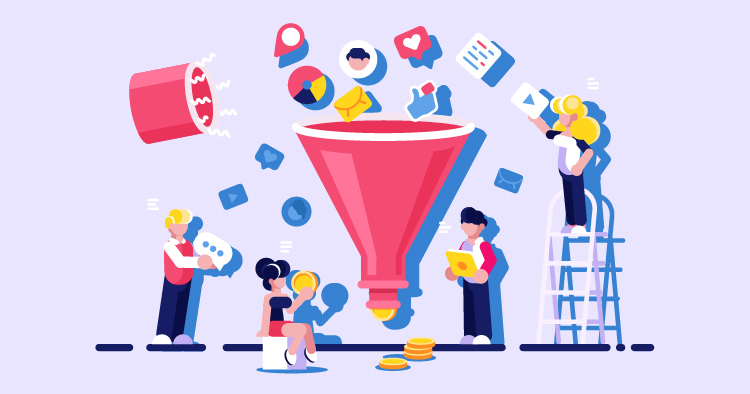Understanding sales funnels is crucial for anyone looking to excel in digital marketing or grow their business online. A sales funnel represents potential customers’ journey to purchase your product or service. It’s a systematic approach to converting casual browsers into loyal customers. This beginner’s guide will demystify the concept of sales funnels, explain their importance, and outline the primary stages that make up an effective funnel. By grasping these fundamentals, you’ll be well on your way to creating strategies that improve conversion rates and drive sales.
Understanding the Sales Funnel
A sales funnel is a tool that helps businesses understand a customer’s journey, from learning about a product or service to making a purchase. Think of it as an actual funnel: many potential customers might enter the broad top, but only a few make it through the narrow end to buy something. The goal is to make this process smooth and efficient, leading to more sales.
What is a Marketing Funnel?
Imagine a funnel that you might use to pour oil into your car. At the top, it’s vast, allowing a lot of oil to enter. As it goes down, the funnel gets narrower until the oil comes out in a thin stream. A marketing funnel is similar. It starts with many potential customers interested in your products or services. As they move through the funnel, they become more engaged with your brand, and the number of people who are still interested gets smaller. At the end of the funnel, the most interested customers purchase.
This is useful because it helps you understand where and why you’re losing potential customers. By examining each stage of the funnel, you can change your marketing strategy to keep more people moving through it. For example, you could create more engaging content, offer better customer service, or make your website easier to navigate.
The sales funnel isn’t static. As your business grows and changes, so should your funnel. By observing how your customers behave, you can adjust your funnel to better suit their needs. This might mean adding new stages to the funnel, changing your messaging, or experimenting with different marketing tactics. The key is constantly learning and improving so that more potential customers turn into actual sales.
Types of Funnels
Let’s dive into the different sales funnels businesses use to guide customers from learning about a product to purchasing. Each type is crafted to suit specific business needs and customer interactions.
Traditional Sales Funnel
A traditional sales funnel is a go-to for many businesses, particularly in the retail and service sectors. It’s built on four key stages:
1. Awareness: Customers learn about a product or service.
Struggling with Digital marketing? Book Your Free Strategy Session!
- 30-Minutes Session
- Expert Insights
- Data-Driven approach
- Optimized Strategies for Your Goals
2. Interest: They look for more details and start considering it.
3. Decision: They compare their options and lean toward a choice.
4. Action: They buy the product or sign up for the service.
This straightforward approach matches well with businesses that have a direct path from showcasing a product to closing a sale.
Consultative Sales Funnel
Businesses that provide personalized services, like consulting or custom services, often use a consultative sales funnel. This funnel is all about deepening customer relationships through steps like:
– Personal discussions
– Complimentary consultations
– Tailored advice
The goal is to build trust and show the actual value of the service before asking for a sale.
Struggling with Digital marketing? Book Your Free Strategy Session!
- 30-Minutes Session
- Expert Insights
- Data-Driven approach
- Optimized Strategies for Your Goals
E-commerce Sales Funnel
E-commerce businesses aim to move customers from finding a product to purchasing it quickly and smoothly. Their funnels focus on user experience with elements like:
– Easy-to-use website layouts
– Straightforward navigation
– Fast checkout processes
A well-designed e-commerce funnel removes hurdles and makes shopping online a breeze for customers.
Content Sales Funnel
Content is critical to driving sales for businesses selling knowledge, like online courses or e-books. Their funnels often feature:
– Educational blog posts
– Detailed articles
– Webinars and online classes
This content doesn’t just teach—it also nudges potential buyers toward a purchase by positioning the business as an expert in its field.
Each funnel type is tailored to guide customers through their buying journey, ensuring every interaction moves them closer to a sale that naturally meets their needs. Whether a business aims for quick sales or long-term client relationships, there’s a funnel strategy to help it succeed.
Understanding Marketing Funnels
Marketing funnels are a roadmap for turning potential customers into buyers. Imagine a funnel that is wide at the top and narrow at the bottom. At the top, many people might become aware of a business, but only a few make it through the narrow end as paying customers. These funnels guide local businesses’ journeys, ensuring the process is smooth and effective from the first point of contact to the final sale.
Local businesses, like a cozy cafe or a trendy clothing store, can significantly benefit from marketing funnels. They can attract people through popular platforms like social media or local listings. Once someone shows interest, the business can engage them with special deals or invite them to community events. It’s all about turning a curious onlooker into someone who walks through the door and makes a purchase.
A marketing funnel does more than sell; it builds a relationship. When a customer feels valued, they’re more likely to return. For example, a simple thank-you email after someone dines at your restaurant or a discount offer for a second visit can make a big difference. Local businesses can use these connections to create a loyal customer base that returns and recommends the company to others.
One of the most significant advantages of a marketing funnel is understanding what works. You can make better decisions by examining how people interact with your marketing efforts and which strategies lead to sales. Maybe you’ll find that your community loves it when you host local artists at your cafe or your boutique’s fashion blog drives in-store visits. With this knowledge, you can focus on what truly matters to your customers, making your business a beloved part of the local landscape.
Coaching Business
A sales funnel is crucial for growing your coaching business. Think of it as a journey where you guide potential clients from first hearing about you to deciding they want to work with you. It starts with something free that grabs their attention, like a free consultation or an eBook packed with valuable tips. This free offer is your way of saying “hello” to potential clients curious about what you can do for them.
Once you’ve caught their interest, it’s about building a relationship. You can send them friendly emails that provide more helpful information, share stories of people you’ve helped, and give them a peek into how you coach. It’s like making a new friend and getting to know each other better with each message. The goal is to make them confident that booking a paid session with you is a great choice.
For your coaching business, a sales funnel does more than attract people; it helps you find the ones ready to take the next step. When someone gets through your funnel, you know they’re interested and more likely to stick around for the long haul. This means you’re not wasting time on people who aren’t a good fit, and you can focus on clients who truly value what you offer. It’s an intelligent way to ensure your marketing efforts hit the mark and bring you the success you aim for.
E-commerce Business
For those running e-commerce businesses, the competition can be fierce. Creating a well-thought-out sales funnel can be a game-changer. It’s like having a roadmap that helps potential customers find what they need and makes it easier for them to buy it. By streamlining the process from when someone first learns about your product to when they complete a purchase, you’re not just making sales—you’re optimizing for more sales with every step.
One of the most significant advantages of a sales funnel is the ability to collect data. As people interact with your online store, you can track which items catch their eye and when they decide to leave. This isn’t just a bunch of numbers and charts—it’s a treasure trove of information that can tell you exactly how to make your online shopping experience better and more effective.
But there’s more. A good sales funnel doesn’t just help you sell what’s in the customer’s cart; it enables you to sell more. By understanding what your customers are interested in, you can suggest other products they like. This isn’t about pushing sales; it’s about providing value. When you recommend products that make sense based on what they’re already buying, you’re helping them and your business. The result? Customers leave happy with more in their bags, and you see a boost in your average sale without spending more on marketing.
Marketing Funnel Strategies
At the beginning of the marketing funnel, you aim to get people to notice your brand. You can use content marketing, social media, and search engine optimization (SEO) to attract attention. It’s all about creating informative and engaging content that helps solve problems for your audience.
Another way to get noticed is through pay-per-click (PPC) advertising. With tools like Google Ads and Facebook Ads, you can ensure your message gets in front of the most likely to be interested in your offer.
The key here is not to push for a sale right away. Instead, provide helpful information, get your brand name out there, and show you know your stuff. This builds brand recognition and positions your business as a trusted authority.
Consideration Stage
Once people know about your brand, you want to build a stronger connection with them. You can do this by offering in-depth guides, video tutorials, or webinars that tackle specific issues they’re facing.
Email marketing is also very effective at this stage. A well-crafted email can deliver significant value and might encourage someone to consider buying from you.
Building trust is vital now. Share customer testimonials and case studies to show people have had great experiences with your products or services. Seeing others’ success can be just what someone needs to purchase.
Action Stage
Now, it’s time to turn potential customers into actual buyers. Use strong calls-to-action, time-sensitive offers, and discounts to motivate them. Creating a sense of urgency can encourage them to leap.
To decide more efficiently, offer money-back guarantees to alleviate any concerns about risk. Various payment options can also help by making buying as hassle-free as possible.
Lastly, monitor your conversion rates closely. Tracking how many people follow through and take action gives insight into how well your marketing funnel works and where adjustments might be needed.
How to Create a Marketing Funnel–Best Practices
Attracting the Right Traffic
Getting people to visit your website is crucial for any marketing funnel. You can draw them in through search engine optimization (SEO), pay-per-click (PPC) advertising, and social media campaigns. It’s essential to select the channels that your potential customers use the most.
When people land on your website, it’s helpful to understand their behavior. Using tools like Google Analytics can shed light on what they do while they’re there. This information is critical to fine-tuning the different stages of your funnel to boost the chances of making a sale.
Remember, it’s not just about getting traffic to your site–it’s about getting the right traffic. By creating detailed profiles of your ideal customers, you can tailor your marketing efforts to attract the most likely to buy from you.
Optimize for Mobile
Most web browsing happens on smartphones and tablets, so it’s essential to ensure your marketing funnel works well on these devices. Your website should be easy to use on a mobile device, but that’s just the start. Every step of the funnel, including emails, landing pages, and checkout, should be straightforward for mobile users.
Making your funnel mobile-friendly doesn’t just improve the user experience; it also helps with your website’s search engine ranking. Google tends to rank mobile-friendly websites higher, which can lead to more organic traffic and potential customers finding your site.
Use Analytics to Refine
Understanding the importance of data is crucial when it comes to sales funnels. Analytics are your best friend here—they provide solid evidence of what’s working and what isn’t. You can get a clear picture of your funnel’s performance by using tools to track your key performance indicators, such as the number of people clicking through and the number of buying.
However, collecting this data alone is not enough. It would be best to dive into it, looking for patterns and pinpointing what’s driving your success. If you spot areas that aren’t doing well, that’s your cue to make changes. And remember, experimenting is key. Try different versions of your funnel parts to see which one your customers prefer. By doing this, you’re fine-tuning your approach based on solid evidence, which can lead to a better-performing funnel over time.
Final Thoughts
As we wrap up this beginner’s guide, remember that mastering sales funnels is an ongoing process that requires patience and continuous optimization. The key to success lies in understanding your audience, delivering value at each funnel stage, and refining your approach using data-driven insights. Whether you’re a small business owner, budding entrepreneur, or marketing professional, a well-structured sales funnel can be the catalyst for achieving your sales goals. Start implementing these principles today, and watch your customer base and revenue grow.



